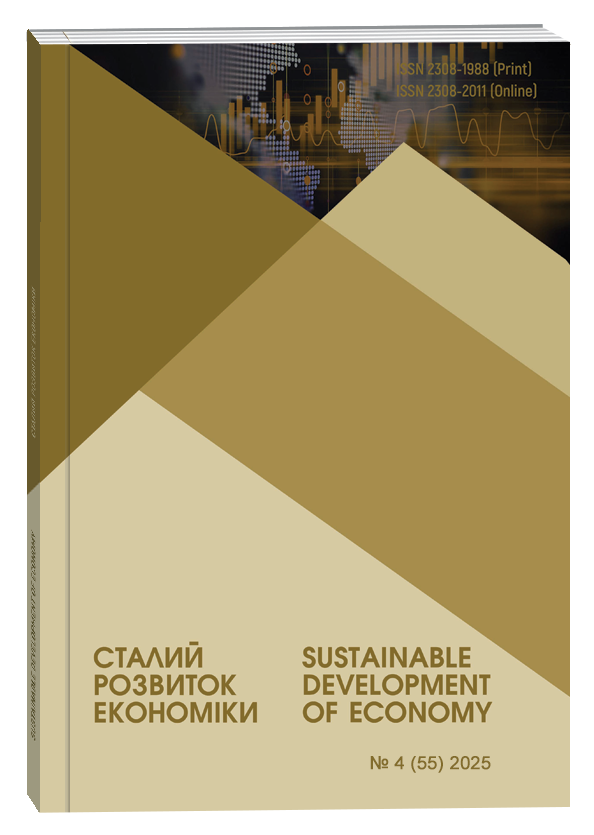REDUCTION OF THE TECHNOLOGICAL COMPLEXITY OF UKRAINE’S PREFERENTIAL TRADE WITH THE EU
Abstract
The article focuses on the disproportionality of the conditions and outcomes of Ukraine’s preferential trade with the EU, one of the critical manifestations of which is the technological imbalance in the structure of bilateral export–import operations. It is substantiated that identifying the depth of technological disparities in preferential trade between Ukraine and the EU is a necessary foundation for outlining future directions to overcome them as a priority of the state’s export strategy. The dynamics of Ukraine’s exports and imports in trade with EU countries during 2011–2024 are analyzed, confirming both the positive effects of the Deep and Comprehensive Free Trade Area (DCFTA) agreement, reflected in the significant growth of export and import volumes, and negative trends, namely the declining balance of Ukraine’s exports to the EU in terms of technological complexity. To analyze technological asymmetry in Ukraine’s trade with the EU, a normalized Product Complexity Index (PCI) was applied, and Ukrainian export and import products in trade relations with the EU were classified by complexity categories – from the first (exports with a high level of knowledge and technology intensity) to the fourth (raw materials and the least technologically sophisticated products). Based on the analysis of changes in the commodity structure of bilateral trade, the study confirms a trend toward a reduction in the technological complexity of preferential trade, which can be interpreted as a sign of Ukraine’s deindustrialization. The paper outlines key directions for minimizing the risks of asymmetric development in Ukraine–EU preferential trade and substantiates the need for Ukraine to focus on developing a long-term strategy for technological sector growth, taking into account the country’s resource potential. In this context, it is advisable to emphasize increasing the production and export of technologically advanced metallurgical products to the EU instead of exporting raw materials and semi-finished goods, as well as developing the food industry through deeper processing of agricultural products.
References
Пирог О.В., Колінко Н.О., Бердей Н.В. Зовнішня торговельна позиція України у ЄС: вивчення тенденцій зміни у період дії воєнного стану. Менеджмент та підприємництво в Україні: етапи становлення та проблеми розвитку. 2024. № 2 (12). С. 323–332. DOI: https://doi.org/10.23939/smeu2024.02.323
Lyzun M., Vitálišová K., Borseková K. Transformation of trade flows between the EU and Ukraine in the conditions of increasing security risks. Journal of European Economy. 2024. Vol. 23, No. 2. P. 289–305. DOI: https://doi.org/10.35774/jee2024.02.289
Маруняк Є.О., Лажнік В.Й., Пугач С.О. Просторова диференціація товарної торгівлі України з країнами ЄС. Український географічний журнал. 2023. № 2 (122). С. 13–24. DOI: https://doi.org/10.15407/ugz2023.02.013
Оболенська Т.Є., Каленюк І.С., Яценко О.М., Пономарьова М.С. Формування та реалізація потенціалу торговельної інтеграції. Вісник ХНАУ ім. В. В. Докучаєва. Серія «Економічні науки». 2020. № 3. С. 251–263. DOI: https://doi.org/10.31359/2312-3427-2020-3-251
Ляшок А.П., Таранюк О.В. Аналіз зовнішньоторговельної діяльності України. Київський економічний науковий журнал. 2024. № 7. С. 90–95. DOI: https://doi.org/10.32782/2786-765X/2024-7-13
Тур О.В., Ляшевська В.І., Куц Н.В. Тенденції формування товарного експорту України в умовах військової агресії. Проблеми сучасних трансформацій. Серія: економіка та управління. 2024. № 16. DOI: https://doi.org/10.54929/2786-5738-2024-16-03-06
Калюжна Н.Г., Дашков С.І. Оцінка технологічного тиску в торгівлі України та ЄС. Зовнішня торгівля: економіка, фінанси, право. 2024. № 4 (135). С. 69–85. DOI: https://doi.org/10.31617/3.2024(135)05
Kalyuzhna N., Khodzhaian A., Baron I. Economic security of Ukraine under the destructive influence of exogenous determinants. Науковий вісник Національного гірничого університету. 2023. № 2. С. 161–170. DOI: https://doi.org/10.33271/nvngu/2023-2/161
Товарна структура зовнішньої торгівлі з країнами ЄС. Державна служба статистики України. URL: https://www.ukrstat.gov.ua/operativ/operativ2021/zd/tsztt_ES/tsztt_ES_u/arh_tsztt_es_2025_u.html (дата звернення: 02.10.2025).
Hidalgo C. A., Hausmann R. The Building Blocks of Economic Complexity. Proceedings of the National Academy of Sciences. 2009. Vol. 106, No. 26. P. 10570–10575. DOI: https://doi.org/10.1073/pnas.0900943106
Pyroh O. V., Kolinko N. O., & Berdei N. V. (2024). Zovnishnia torhovelna pozytsiia Ukrainy u YeS: vyvchennia tendentsii zminy u period dii voiennoho stanu [Foreign trade position of Ukraine in the EU: study of change trends during the period of marital status]. Menedzhment ta pidpryiemnytstvo v Ukraini: etapy stanovlennia ta problemy rozvytku, no. 2(12), pp. 323–332. DOI: https://doi.org/10.23939/smeu2024.02.323 (in Ukrainian)
Lyzun M., Vitálišová K., & Borseková K. (2024). Transformation of trade flows between the EU and Ukraine in the conditions of increasing security risks. Journal of European Economy, vol. 23, no. 2, pp. 289–305. DOI: https://doi.org/10.35774/jee2024.02.289
Maruniak Ye.O., Lazhnik V.Y., & Puhach S.O. (2023). Prostorova dyferentsiatsiia tovarnoi torhivli Ukrainy z krainamy YeS [Spatial differentiation of commodity trade between Ukraine and EU countries]. Ukrainskyi heohrafichnyi zhurnal, no. 2(122), pp. 13–24. DOI: https://doi.org/10.15407/ugz2023.02.013 (in Ukrainian)
Obolenska T. Е., Kaleniuk I. S., Yatsenko O. M. & Ponomaryova M. S. (2020). Formuvannia ta realizatsiia potentsialu torhovelnoi intehratsii [Formation and realization of trade integration potential]. Visnyk KhNAU im. V.V. Dokuchaieva. Seriia «Ekonomichni nauky», no. 3, pp. 251–263. DOI: https://doi.org/10.31359/2312-3427-2020-3-251 (in Ukrainian)
Liashok A. Р., & Taraniuk O. V. (2024). Analiz zovnishnotorhovelnoi diialnosti Ukrainy [Analysis of Ukraine's foreign trade activity]. Kyivskyi ekonomichnyi naukovyi zhurnal, no. 7, pp. 90–95. DOI: https://doi.org/10.32782/2786-765X/2024-7-13 (in Ukrainian)
Tur O. V., Liashevska V. I., & Kuts N. V. (2024). Tendentsii formuvannia tovarnoho eksportu Ukrainy v umovakh viiskovoi ahresii [Trends in the formation of Ukraine's commodity exports under conditions of military aggression]. Problemy suchasnykh transformatsii. Seriia: ekonomika ta upravlinnia, no. 16. DOI: https://doi.org/10.54929/2786-5738-2024-16-03-06 (in Ukrainian)
Kalyuzhna N., & Dashkov S. (2024). Otsinka tekhnolohichnoho tysku v torhivli Ukrainy ta YeS [Assessment of technological pressure in Ukraine–EU trade]. Zovnishnia torhivlia: ekonomika, finansy, pravo, no. 4(135), pp. 69–85. DOI: https://doi.org/10.31617/3.2024(135)05 (in Ukrainian)
Kalyuzhna N., Khodzhaian A., & Baron I. (2023). Economic security of Ukraine under the destructive influence of exogenous determinants. Naukovyi visnyk Natsionalnoho hirnychoho universytetu, no. 2, pp. 161–170. DOI: https://doi.org/10.33271/nvngu/2023-2/161
Tovarna struktura zovnishnoi torhivli z krainamy YeS [Commodity structure of foreign trade with EU countries]. Derzhavna sluzhba statystyky Ukrainy. Available at: https://www.ukrstat.gov.ua/operativ/operativ2021/zd/tsztt_ES/tsztt_ES_u/arh_tsztt_es_2025_u.html (in Ukrainian)
Hidalgo C.A., & Hausmann R. (2009). The Building Blocks of Economic Complexity. Proceedings of the National Academy of Sciences, vol. 106, no. 26, pp. 10570–10575. DOI: https://doi.org/10.1073/pnas.0900943106


